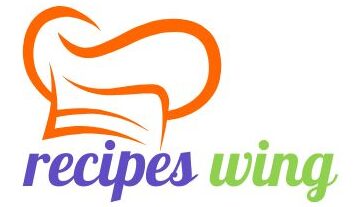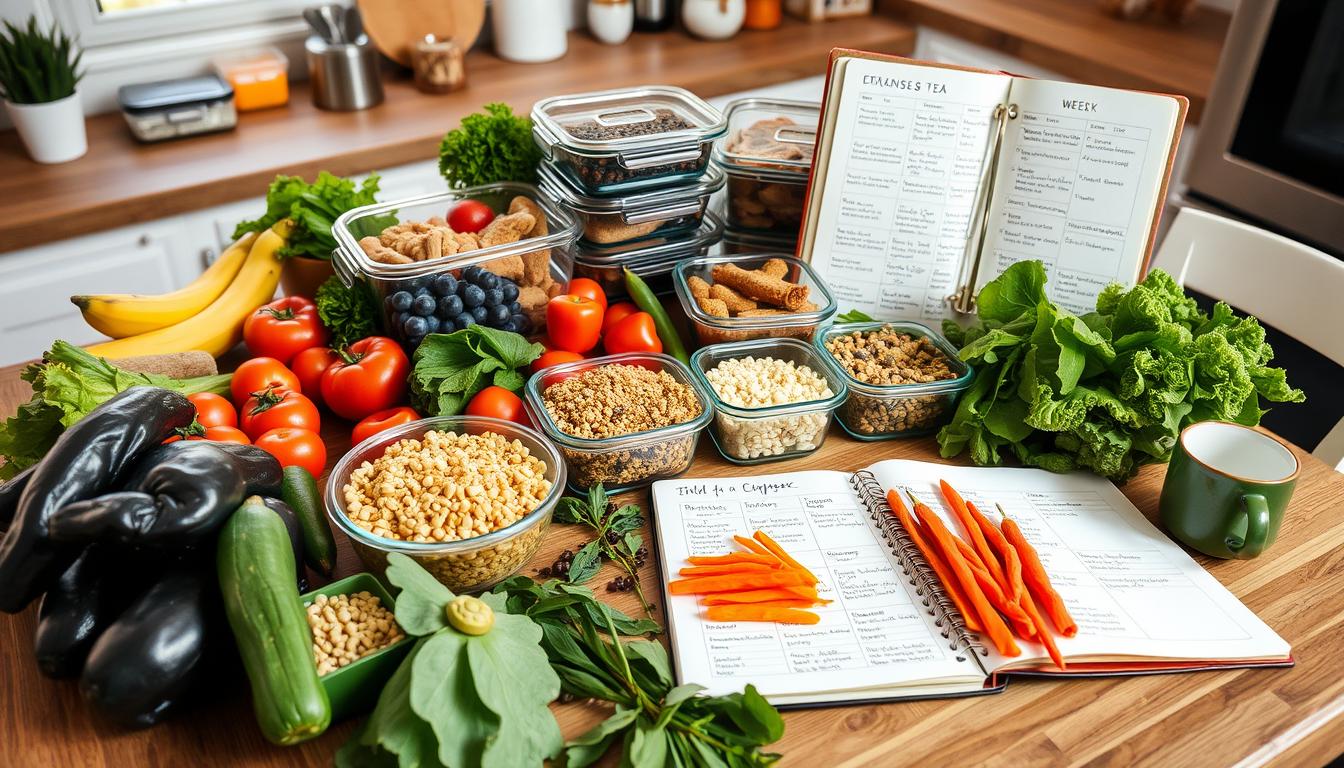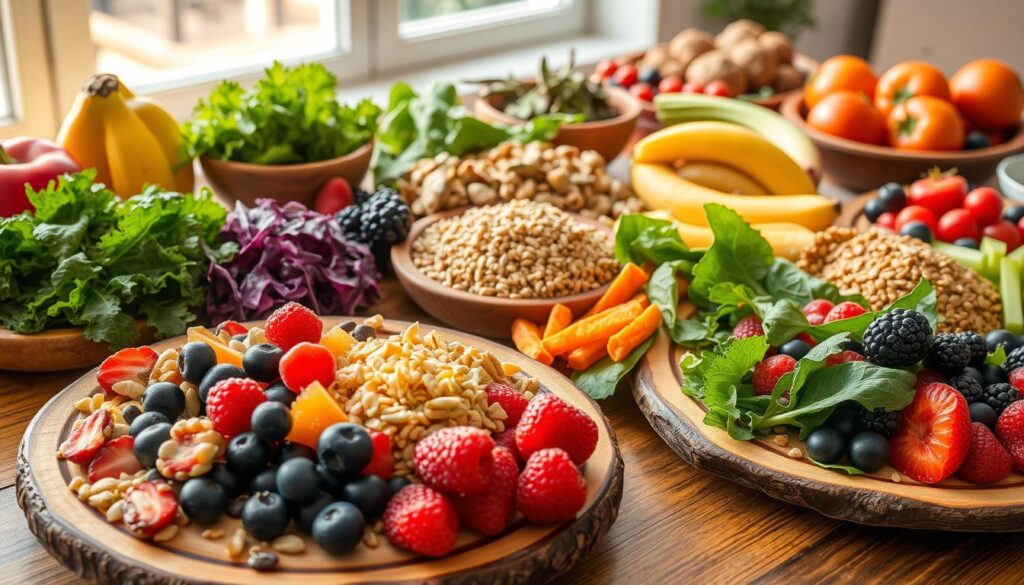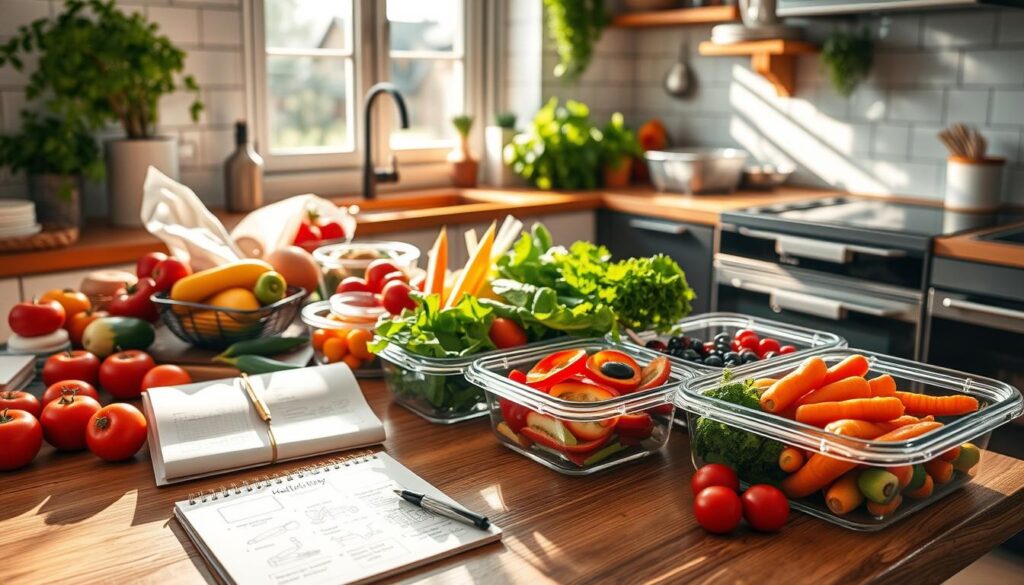What should I eat tomorrow?Staring at your fridge, you wonder, “What should I eat tomorrow?” Meal planning can seem overwhelming. But, it doesn’t have to be. This guide will help you take charge of your nutrition. You’ll make choices that are good for your body and taste great.
Key Takeaways
- Discover the fundamentals of clean eating for optimal health
- Learn practical strategies to streamline your meal planning process
- Explore a variety of nutritious breakfast, lunch, and dinner options
- Uncover time-saving kitchen hacks to simplify your cooking routine
- Discover budget-friendly ways to enjoy delicious, wholesome meals
Looking to boost your health, manage a health issue, or just enjoy cooking more? This guide is for you. Let’s start a journey to make healthy, tasty meals easy every day.
Understanding the Basics of Clean Eating
Clean eating is a way of life that focuses on eating whole, unprocessed foods. It includes whole grains, fresh fruits and veggies, lean proteins, healthy fats, and legumes. The goal is to feed your body with the nutrients it needs, avoiding added sugars, sodium, and unhealthy fats.
What Defines Clean Eating
Clean eating is all about choosing whole foods over processed ones. It means picking foods that are as natural as possible, without preservatives or artificial colors. It also means cutting down on refined carbs like white bread for whole grains.
Benefits of Clean Eating
Starting a clean eating lifestyle can greatly benefit your health. It can boost your energy, improve digestion, help with weight management, and lower the risk of chronic diseases. It can also lead to better skin, stronger hair and nails, and more vitality.
Essential Nutritional Components
The core of clean eating includes three main nutrients: protein, healthy fats, and complex carbohydrates. Lean proteins like chicken, fish, and legumes help build and repair muscles. Healthy fats from avocados, nuts, and olive oil support brain and heart health. Complex carbs from whole grains and starchy veggies give you energy and fiber for good digestion.
“Clean eating is not a diet, but a lifestyle that emphasizes whole, unprocessed foods for optimal health and well-being.”
By learning about clean eating and its key nutrients, you can start a journey to a healthier, more vibrant life.
What Should I Eat Tomorrow?
Planning meals can feel like starting over every day. This leads to quick, unhealthy choices and feeling deprived. To change this, focus on making small, lasting changes.
Don’t wait for tomorrow to change your diet. Plan your meals ahead. This way, you get a mix of balanced nutrition and save time and food by using ingredients wisely.
First, check what you have in your kitchen. Make a list of meals you can make with what you have. This helps you avoid buying too much at the store and find new recipe inspiration.
| Ingredient | Potential Meals |
|---|---|
| Chicken breasts | Grilled chicken salad, stir-fry with vegetables, chicken tacos |
| Brown rice | Rice bowls with roasted vegetables, rice and beans, fried rice |
| Broccoli | Steamed broccoli with lemon, broccoli stir-fry, broccoli soup |
By planning ahead, you can have many balanced nutrition options ready. This makes it easier to choose healthy meals every day.
Smart Meal Planning Strategies
Effective meal planning is key to a healthy diet. It saves time and money and nourishes your body. Let’s look at some smart ways to plan your meals.
Setting Up Your Kitchen for Success
Start by organizing your kitchen. Clean out your pantry, fridge, and cabinets. This makes meal prep easier.
Group similar items and label containers. Use storage solutions to keep food fresh and easy to find.
Time-Saving Preparation Tips
- Batch cooking saves time. Cook big batches of proteins, grains, and veggies on weekends.
- Pre-chop veggies in advance. This makes quick meals easier to prepare.
- Use kitchen appliances like slow cookers and Instant Pots. They make cooking faster.
Cross-Utilizing Ingredients
Plan meals that use the same ingredients. For example, use grilled chicken in stir-fries and tacos. Roast big batches of veggies for different dishes.
“Meal prepping can save time on busy weeknights, making food available to heat and eat when coming home.”
With these strategies, meal prep becomes easy. Enjoy a well-organized kitchen and a fridge full of ingredients ready to go.
Essential Ingredients for Weekly Meal Prep
Having a well-stocked pantry and fridge is crucial for meal prep success. Stock up on pantry staples, meal prep ingredients, and versatile foods. These items are the base for your weekly meals, making it easy to cook healthy and tasty dishes.
Some key ingredients to have include:
- Whole grains like quinoa, brown rice, and whole wheat pasta
- Lean proteins such as chicken breasts, ground turkey, and canned beans
- Frozen vegetables for quick and easy sides
- Healthy fats like avocado, nuts, and olive oil
- Canned tomatoes, sauces, and spices for flavor
- Fresh produce that lasts longer, like apples, citrus fruits, and root vegetables
With these ingredients, you can quickly make a variety of balanced meals. This makes meal prep easy and efficient.
| Dish | Calories | Fat (g) | Sodium (mg) | Carbs (g) | Protein (g) |
|---|---|---|---|---|---|
| Coconut-Ginger Chickpeas & Tomatoes | 402 | 12 | 590 | 65 | 11 |
| Korean Bulgogi Beef & Rice | 413 | 13 | 647 | 46 | 27 |
| Egg Roll Noodle Bowl | 302 | 12 | 652 | 33 | 14 |
With these pantry staples, meal prep ingredients, and versatile foods, you’re set to make delicious meals all week.
Building Balanced Meals
Making balanced meals is key for good balanced nutrition and health. When you plan your meals, aim to include many nutrient-rich foods. This ensures your body gets all the vitamins, minerals, and macronutrients it needs.
Protein Sources
Add lean protein sources like chicken, fish, tofu, or legumes to your meals. These foods help build and repair muscles. They also keep you full and happy.
Whole Grains and Complex Carbohydrates
Go for whole grains and complex carbohydrates like quinoa, brown rice, or sweet potatoes. These foods give you lasting energy, fiber, and lots of vitamins and minerals.
Healthy Fats and Vegetables
Include healthy fats from avocados, nuts, and olive oil. They support brain function, hormone balance, and nutrient absorption. Also, add a variety of colorful vegetables to get a wide range of vitamins, minerals, and antioxidants.
By focusing on balanced meal composition, you’ll nourish your body with the nutrients it needs to thrive.
“Eating a balanced diet rich in nutrient-dense foods is the foundation for optimal health and wellbeing.”
Make-Ahead Breakfast Ideas
Struggling to find time for a nutritious breakfast in the morning? Don’t worry! With a bit of planning, you can have tasty and healthy breakfasts ready. Try overnight oats or freezer-friendly breakfast burritos. These ideas will help you start your day well, without the morning rush.
Overnight Oats
Overnight oats are a great quick morning meal. Just mix rolled oats, milk or yogurt, and your favorite toppings like fruit, nuts, or chia seeds. Refrigerate it overnight, and you’ll have a healthy breakfast in the morning.
Breakfast Burritos
Make a batch of breakfast burritos on the weekend. Store them in the freezer for a quick breakfast prep option. Wrap them in foil or parchment paper. Then, reheat them in the oven or microwave for a tasty and healthy breakfast.
Smoothie Packs
Pre-portion your smoothie ingredients into bags or containers. Freeze them, and blend with your favorite liquid for a quick and healthy breakfast.
Frittatas and Quiches
Bake a large frittata or quiche on the weekend. It’s a quick morning meal that can be reheated all week. You can add your favorite veggies, proteins, and cheeses for a healthy breakfast that’s easy and satisfying.
Hard-Boiled Eggs
Make a batch of hard-boiled eggs in advance. Store them in the fridge. Grab a few as you’re leaving for a quick morning meal that’s packed with protein.
By preparing these make-ahead breakfast options, you can start your day with a nutritious meal. Even on the busiest mornings, you’ll have a satisfying breakfast ready.
Lunch Planning Strategies
Packing a healthy lunch can change your workday. Plan ahead and cook in batches to save time. You’ll have nutritious meals ready to go. Try mason jar salads, wraps, or bento boxes with small portions.
Portable Lunch Solutions
- Mason Jar Salads: Layer your favorite greens, veggies, proteins, and dressings in a Mason jar for a mess-free, grab-and-go lunch.
- Wraps: Whole wheat tortillas or lettuce leaves make a great base for fillings like grilled chicken, hummus, and crunchy vegetables.
- Bento Boxes: Compartmentalized containers allow you to pack a balanced meal with a protein, complex carb, and fresh produce.
Batch Cooking for Work Week
Spending a few hours on the weekend cooking can save you time. Prepare proteins like grilled chicken, roasted veggies, or quinoa salad. These can be used in many lunches.
Plan ahead and pack lunches to avoid unhealthy snacks. Focus on packed lunches, meal prep for work, and healthy lunch ideas. They’ll keep you energized and focused all day.
Dinner Preparation and Planning
Weeknight dinners can be easy with a bit of planning. Learn to make easy dinner recipes and weeknight meals for your family dinner ideas. There are many options, like slow cooker dishes and one-pan wonders, to make your evening meals simpler.
Begin by prepping ingredients ahead of time. Marinate meats, chop veggies, and gather everything before dinner. This saves time and energy when you’re hungry. Also, make extra of meals like soups or sauces to freeze for later. This way, you can quickly heat up a meal on busy nights.
Use quick cooking methods like slow cookers or sheet pan dinners to cut down on cleanup. These recipes are easy to make. Just mix everything together and let it cook. Serve with a fresh salad or steamed veggies for a complete family dinner idea.
Lastly, be creative with leftovers. Plan meals that use ingredients from previous nights. This reduces waste and saves time. With some planning, you can enjoy tasty, easy dinner recipes all week without stress.
“The key to successful weeknight meal planning is having a repertoire of go-to recipes that are quick, healthy, and family-friendly.”
Food Storage and Organization Tips
Proper food storage and kitchen organization can cut down on waste, make meal prep easier, and save money. Let’s look at some easy ways to keep your fridge, freezer, and pantry tidy.
Refrigerator Organization
Get clear containers and labels to spot prepped foods and leftovers easily. Use the FIFO method to avoid expired food. Also, clean out your fridge often to make room for new groceries.
Freezer Storage Guidelines. What should I eat tomorrow?
Freeze food in airtight containers or bags to avoid freezer burn. What should I eat tomorrow? Mark what’s inside with the date. Keep your freezer neat by grouping similar items together. Check freezer storage times to keep food fresh.
Pantry Management
Sort your pantry by type, like canned goods and grains. Use the oldest items first to cut down on waste. Use airtight containers to keep food fresh and pests away. Always check expiration dates and toss expired or bad food.
| Food Item | Pantry | Refrigerator | Freezer |
|---|---|---|---|
| Canned Goods | 12-18 months (acidic), 2-4 years (less acidic) | – | – |
| Dried Beans, Legumes, Lentils | Indefinite | – | – |
| Dry Pasta | Up to 2 years | – | – |
| Rice | 6-8 months | 8-12 months | 3-5 years (white rice) |
| Nuts | 3-6 months | – | Up to 2 years |
| Dried Fruits | Up to 1 year | – | Indefinite |
By following these food storage and kitchen organization tips, you’ll reduce food waste, make meal prep easier, and save money.
Time-Saving Kitchen Hacks
Streamlining meal prep can change your cooking game. A few kitchen hacks can cut down kitchen time without sacrificing taste or health. Here are 10 tips to save time and enhance your cooking experience. What should I eat tomorrow?
- Use your food processor for quick chopping and slicing. It’s a time-saver for prep work.
- Get an Instant Pot or pressure cooker for faster soups, stews, and proteins.
- Prep ingredients like chopped veggies, marinated meats, and grains on the weekend. It saves time later.
- Double recipes and freeze leftovers for future meals. It’s a great way to save time.
- Get your family involved in kitchen tasks. It’s a fun way to share the workload.
- Try one-pot or sheet pan recipes for less cleanup. They’re efficient and easy.
- Stock your pantry and freezer with versatile ingredients. It makes meal prep a breeze.
- Label and date containers in your fridge and freezer. It helps you find what you need quickly.
- Organize your kitchen with designated spots for items. It makes everything more accessible.
- Use a meal planning app or template. It simplifies planning and shopping.
By using these cooking tips, efficient meal prep, and kitchen shortcuts, you can save time. This lets you enjoy making healthy, tasty meals for your family.
| Meal Prep Hack | Benefit |
|---|---|
| Batch cooking | Reduces costs by taking advantage of bulk buying discounts |
| Freezing meals | Saves time by having pre-cooked meals ready to go |
| Meal planning | Lowers food budget by preventing unnecessary purchases |
| Utilizing kitchen tools | Streamlines prep work and cooking times |
Proper meal planning and preparation can significantly reduce the time spent in the kitchen, allowing you to focus on enjoying the cooking process and the delicious results.
Budget-Friendly Meal Planning. What should I eat tomorrow?
Creating healthy meals on a budget is easy with some planning and smart shopping. You can make tasty dishes without spending a lot. This guide will help you save on affordable meal prep, grocery budgeting, and cost-effective recipes.
Focus on seasonal produce and sale items to save money. Use discounted fruits and veggies when they’re plentiful. Also, buy in bulk for items like grains or beans to save over time.
Plant-based proteins like lentils and beans are cheaper than meat. They’re great for stretching your budget without losing nutrition.
| Ingredient | Cost per Pound | Amount Used | Total Cost |
|---|---|---|---|
| Ground Beef 80/20 | $3.99 | 3.17 lbs | $12.66 |
| Bacon | $3.79 | 1 lb | $3.79 |
| Chicken Leg Quarters | $0.89 | 1.25 lbs | $1.11 |
| Cheddar Cheese | $1.79 per 8 oz | 5 lbs | $8.94 |
| Eggs | $1.29 per dozen | 1 dozen | $1.29 |
| Sour Cream | $1.69 per 16 oz | 16 oz | $1.69 |
| Frozen Vegetables | $1.19 per 16 oz | 32 oz | $2.38 |
Plan meals that use similar ingredients to save money. This also reduces food waste by using all your ingredients.
By using these strategies, you can enjoy healthy, tasty, and cost-effective recipes without overspending. With a bit of creativity and focus on affordable meal prep, you’ll please your taste buds and your wallet.
Conclusion
Effective meal planning can greatly benefit your life. It saves time, money, and reduces stress. By following the strategies in this guide, you can make healthy eating a part of your lifestyle.
Consistency is crucial. Even small changes can lead to big improvements in your health. This is how you achieve a better life.
Eating nutrient-dense foods is essential for long-term health. It boosts your brain, heart health, and overall well-being. Thoughtful meal planning can change your life for the better.
Your health is the most important thing. The choices you make today affect your future. Start using the strategies from this guide to live a healthier, more vibrant life.
FAQ
What defines clean eating?
Clean eating means eating whole foods like grains, fruits, and veggies. It also includes lean proteins and healthy fats. You should avoid added sugars, sodium, and saturated fats.
What are the benefits of clean eating?
Clean eating boosts health, energy, and helps with weight. It’s all about fiber, lean proteins, and healthy fats from nuts, avocados, and olive oil.
How can I create balanced meals?
Make balanced meals by mixing nutrients. Include lean proteins, whole grains, veggies, and fruits in your dishes.
What are some time-saving meal prep tips?
Save time by batch cooking and pre-chopping veggies. Use slow cookers and plan meals that share ingredients. This cuts down on prep time and waste.
What are some essential ingredients for weekly meal prep?
Stock up on whole grains, lean proteins, and frozen veggies. Keep canned beans, tomato sauce, and spices ready. Use fresh produce like apples and citrus fruits that last longer.
How can I prepare healthy and portable lunches?
Try mason jar salads, wraps, or bento boxes. Batch cook items like grilled chicken and quinoa salad for multiple lunches.
What are some tips for organizing my kitchen for meal prep success?
Use clear containers and labels in your fridge. Follow FIFO to avoid waste. Store food properly and group similar items in your pantry.
How can I save time in the kitchen when meal prepping?
Use kitchen hacks like food processors and pressure cookers. Prep in bulk and freeze. Choose recipes that clean up quickly.
How can I plan meals that are both nutritious and budget-friendly?
Plan with seasonal produce and sales. Buy in bulk and freeze. Use plant-based proteins like beans and lentils. Plan meals that use similar ingredients to reduce waste.



